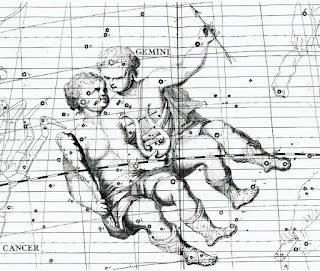
Louis Faurer, Twin Sisters, New York, 1948
I think I am particularly fascinated by twins for two reasons:
One.) My mother is one of a pair of fraternal twins. Mom is Carol. My aunt is Cheryl. Cute names were a trend in post WWII baby booming America.

Here they are at age 12
From what I have gathered about being a twin is that the part that seems to be problematic is that one's particular identity is sometimes uncomfortably overshadowed by the phenomenon of the pair.
Another thing about my mother's being a twin...there is a possibility of myself bearing twins in the future.
Two.) My astrological sign is Gemini.

The astrological sign of gemini gets its name from Greek and Roman mythology. Kastor and Polydeuces (Castor and Pollux) are twin sons of Leda. Leda was their mother, who had been seduced by Zeus while he was in the form of a swan. Zeus then became the children's "divine" father, while the twins went on to live with a "foster," mortal, father, Tyndareus.
The interesting part about the detail of the fathers is that in the stories about the twins, they are inconsistently referred to as divine and/or mortal.
Therefore, twins are often cast as the symbolic representation of duality.

Diane Arbus, Identical Twins

Disfarmer, Untitled, Heber Springs Arkansas, circa 1940s
Since ancient times in religions and philosophies all over the world, dualisms in life have been major sources of inquiry, thought, and debate.
Common dualities include :
Mortal / Divine
Sacred / Secular
Physical / Mental
Emotional / Logical
Reason / Passion
Nature / Nurture
Body / Soul
____________________________________
Where is the line between the body and the mind?
Where the body is a collection of organic and physical elements, chemicals and sensory systems, the mind is one's internalization of environment and circumstances into consciousness, awareness, and creation.

Joaquin Trujillo, from the series, Los Ninos
How do two individuals, borne from the same substance, live in, react to, and understand the world differently?













